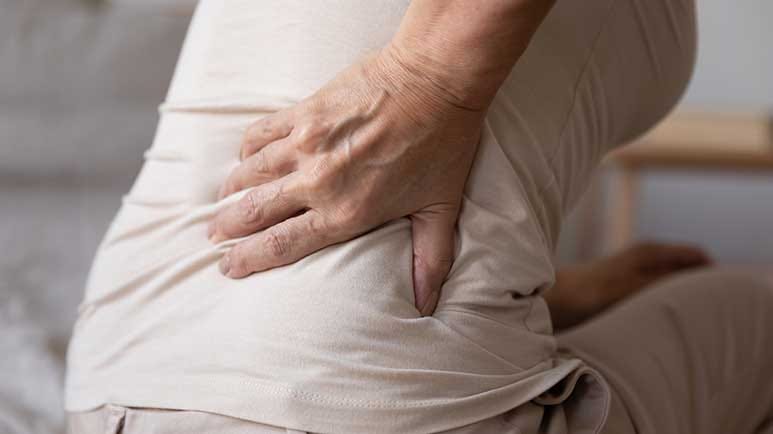Rates of Postmenopausal Low Back Pain Have Nearly Doubled in 30 Years
Description
STORY AT-A-GLANCE
Low back pain is projected to affect over 800 million people worldwide by 2050. Among women over 55, cases nearly doubled from 89.9 million in 1990 to 176.8 million in 2021
Aging populations are the main driver of this increase, but postmenopausal women face a greater risk due to bone loss, muscle decline, fat redistribution, and immune and inflammatory changes
Hormonal shifts during and after menopause alter bone density, disc health, and tissue repair, making the spine more vulnerable to stress and chronic pain
Persistent low back pain is linked to multiple chronic conditions, including cardiovascular disease, metabolic disorders, mental health issues, and long-term functional decline
Regular movement, stronger core and pelvic floor muscles, improved posture, quality sleep, and stress management are among the most effective ways to lower pain risk and protect your spine

Low back pain is the most common musculoskeletal disorder and the leading cause of disability worldwide. As populations grow older, the number of people affected continues to climb. According to the Global Burden of Disease (GBD) Study, more than 800 million people are projected to be living with low back pain by 2050,1 putting their mobility, independence, and long-term health at risk.
If you’re a woman past midlife, your chances of developing postmenopausal low back pain are even higher. To gain a better understanding of this trend, a new global analysis published in Frontiers in Endocrinology2 examined the burden of low back pain in postmenopausal women, emphasizing the importance of earlier recognition, targeted care, and long-term strategies to support healthy aging.
What the New Data Shows About Postmenopausal Low Back Pain
To determine the number of postmenopausal women living with chronic low back pain, researchers drew from the GBD Study 2021, a long-running project that compiles standardized estimates of disease incidence, prevalence, and disability across 204 countries and territories. This dataset covers the years 1990 through 2021, making it one of the most comprehensive sources of information available for global health trends.3
Population focus and study design — The study focused on women aged 55 and older, representing the postmenopausal population. The researchers looked at how often new cases developed each year, how many women were living with chronic low back pain overall, and how much disability the condition caused. Disability was measured in disability-adjusted life years (DALYs), which indicates both the years lost to early death and the years lived with pain or limited mobility.
Sharp rise in total cases — The total number of women over 55 living with low back pain rose sharply between 1990 and 2021. In 1990, there were an estimated 89.9 million prevalent cases worldwide. By 2021, that number had nearly doubled to 176.8 million.
<label class="hide-text" contenteditable="false">Text within this block will maintain its original spacing when published</label>The number of new cases each year also climbed, increasing from 35.2 million to 70.3 million. These increases reflect a growing absolute burden of low back pain in this population, driven in part by demographic shifts.
Disability associated with low back pain also rose significantly — In 1990, postmenopausal women lost an estimated 9.8 million years to low back pain-related disability. By 2021, that figure had reached 19.1 million years. This metric does not account for deaths caused directly by low back pain, which are rare, but instead captures the years spent living with pain, reduced function, and limitations in daily life.
Global rise in cases reflects aging, not worsening risk — Even though the total number of women with low back pain has gone up a lot, the actual rate after adjusting for age has only gone down slightly. This means your individual risk hasn’t changed much over time, but more people are affected overall because the world’s population is older and larger than it used to be.
<label class="hide-text" contenteditable="false">Text within this block will maintain its original spacing when published</label>Still, women after menopause are more affected than men their age. In 2021, women had 1.78 times more new cases and 1.86 times more prevalent cases than their male counterparts.
High BMI leads the list of modifiable risks — The study examined three major modifiable risk factors — high body mass index (BMI), smoking, and occupational or environmental exposures. Among these, high BMI emerged as the leading contributor to low back pain-related disability, accounting for 14.2% of all DALYs.
<label class="hide-text" contenteditable="false">Text within this block will maintain its original spacing when published</label>Occupational factors followed at 12.6%, with smoking contributing 7.3%. These percentages reflect the global average, but the influence of each risk factor varied by region. High BMI had the strongest impact in high-income countries, while occupational risks were more prominent in low- and middle-income regions, where physically demanding labor remains common.
Regional differences by socioeconomic status — To explore these variations further, the researchers stratified results by region using the Sociodemographic Index (SDI), which classifies countries by income, education, and fertility levels.
<label class="hide-text" contenteditable="false">Text within this block will maintain its original spacing when published</label>This approach showed that women in high-SDI regions generally experienced greater disability due to metabolic stressors like excess weight, while women in lower-SDI regions were more likely to be affected by work-related exposures. In both cases, the underlying risk factors are modifiable, meaning they are influenced by behavior, environment, or policy and could be targeted through intervention.
Why Postmenopausal Changes the Back Pain Equation
The transition into menopause triggers a cascade of physiological shifts throughout your body. While many women expect hot flashes and mood changes, fewer realize that menopause fundamentally alters the biological environment supporting the spine. The biological changes include:4 5
<s






